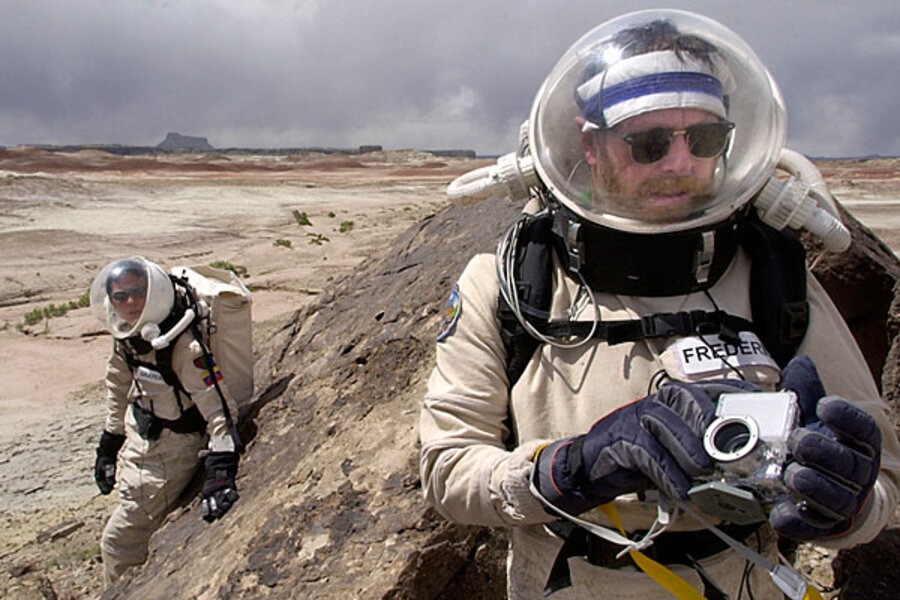Packing light for Mars? Bring genetically modified algae
Loading...
When packing for a manned mission to Mars or the moon, the best thing to bring may not be food or fuel, but specially designed organisms that can create those things for you.
Scientists are researching the possibility of engineering synthetic organisms that would use the resources available in the solar system to create the supplies astronauts would need to survive on another planet.
"Personally I'm interested in space settlement," said John Cumbers, a graduate student at NASA's Ames Research Center in Moffett Field, Calif., who is researching synthetic microbes. "I think we have two choices: We can either go into space and be living inside a tin can, or we can be going into space and recreating in space some of the beauty of nature we have here on Earth."
IN PICTURES: Space photos of the day
Cumbers said he wasn't advocating terraforming, or completely restructuring the surface of a planet to mimic Earth, but rather using bioengineered organisms in a planned and contained way to make life easier in an alien environment. [Mars Base Gallery]
"I think there's a lot that we can do that's productive with biology without having to release organisms in an unplanned fashion," Cumbers told Astrobiology Magazine.
The dangers of 'Frankenlife'
Even with careful planning, this concept could bring risks, as some experts warn against creating "Frankenlife" that could become an invasive species with unintended consequences for humans or the alien environment, including any native life.
However, other scientists advise reining in fears.
"I don't think this would be particularly hazardous," said Chris McKay, a planetary scientist at Ames who is not involved in Cumbers' project. "The sort of organisms that would be good at doing mineral extraction – acidophiles, for example -- are not the type of organisms that cause disease."
And, he said, these synthetic organisms would present no more risk of contaminating the search for alien life than would the normal microbes being carried by humans and spacecraft.
"In any case, we will have to learn how to tell the difference between contamination from Earth and alien life," McKay said.
Making life easier
To design an organism for use on another planet, researchers want to mix and match desired qualities from multiple species. For example, they might start with a species that can do something useful, such as processing materials into biofuels or food. But this species might not be fit for a harsh environment such as on the surface of Mars, where there is no atmosphere to block harmful ultraviolet radiation, and where temperatures can reach frigid depths.
To fix that problem, researchers might want to give that organism genes from extremophile life — species on Earth that are adapted to extreme environments and are well-suited to tolerate cold and resist UV radiation.
Scientists have already achieved some successes in this quest. Cumbers described an experiment in which researchers genetically engineered an E. coli bacterium to survive at lower temperatures than it normally does. They accomplished this by transferring into an E. coli cell the genes from a chaperone from a cold-tolerant organism found in sea ice. A chaperone is a protein that helps other proteins to fold correctly.
One goal that could prove useful for space exploration is creating a synthetic version of spirulina, a dietary supplement made from microscopic algae produced by cyanobacteria. Spirulina is a complete protein, meaning it contains all of the essential amino acids humans need in their diet. That makes it an ideal food to bring on a space mission.
But spirulina generally grows in open ponds in the warm waters of Hawaii – so adapting it to life on, say, the moon is an engineering challenge.
Packing for space
One reason bioengineered organisms are so appealing for space travel is that they could open up a lot of room in astronauts' suitcases. The more supplies space travelers can produce once they arrive at their destination, the less they have to pack on the spacecraft.
"For manned missions to the moon or Mars we're going to have to take nearly everything with us, at least at the beginning," Cumbers said. "If we have this new technology where we can take the complete genome of an organism and send it into space — and can have that single cell replicate from the resources it finds around it rather than resources we've taken with us — then we've started to tackle the problem."
Cumbers presented his work with Lynn Rothschild, his adviser at Ames, at the Astrobiology Science Conference in League City, Texas, in April.





